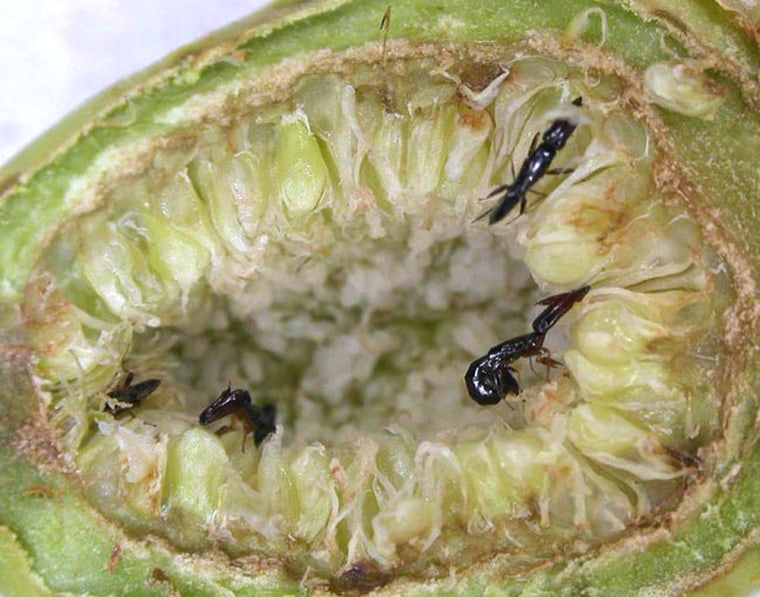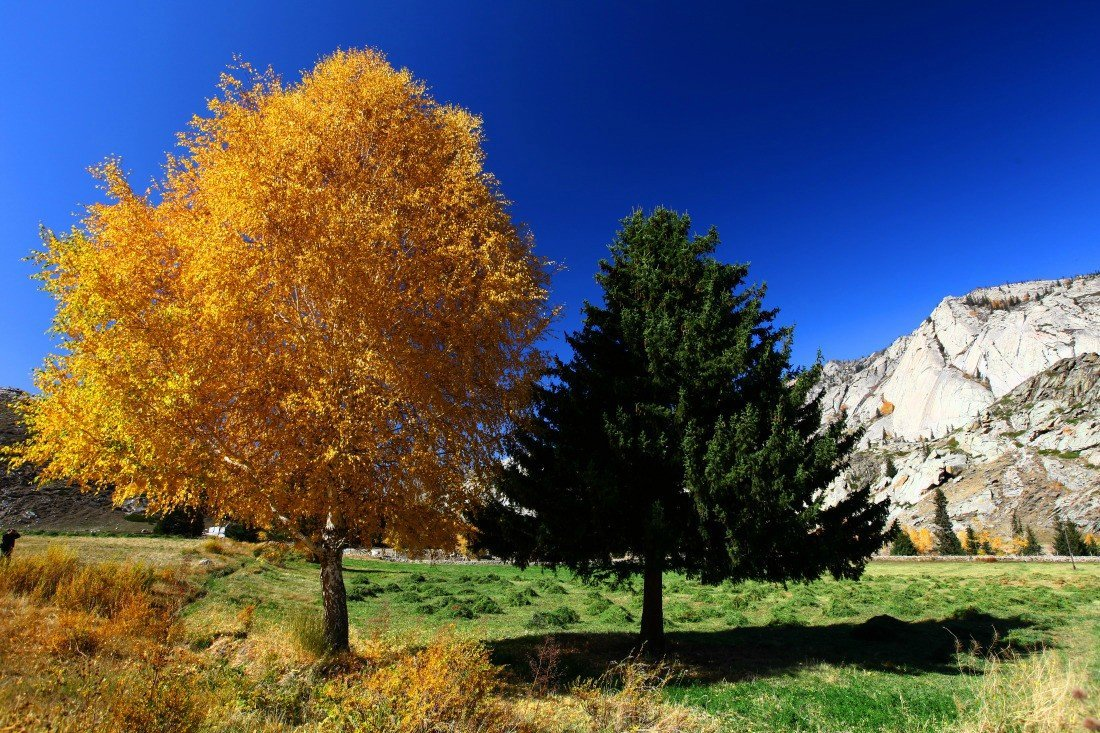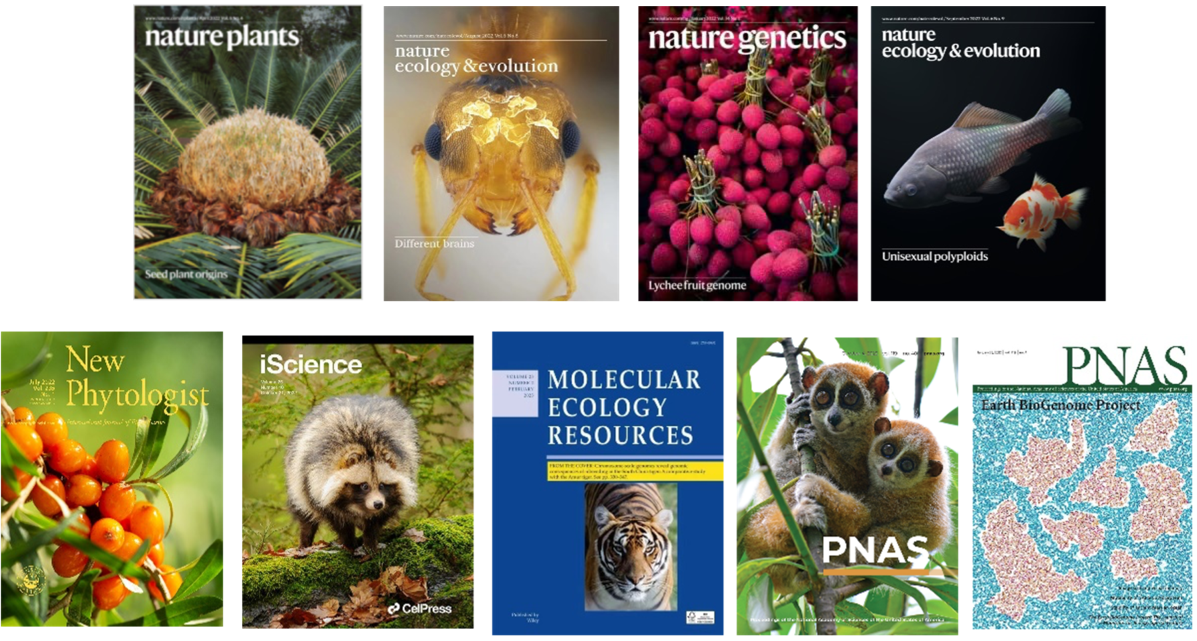The moon is beautiful. You stand in the chill February wind but don’t feel the cold. The flowers you handpicked bloom in your slightly sweating hands, and your heart is pounding with the sight of your loved one appearing far away. On February 14, every year, romancing moments like this repeat throughout the world. The natural world, too, shows its romantic side, and it doesn’t have to be on February 14.
The perfect place for the perfect one
On a quiet summer night in the North American continent, the Yucca (Yucca glauca) stretches out its long panicles with the milky white flowers blooming on them – like the glowing neon lights on the top of a hotel building. It is looking forward to the arrival of its close partner, the yucca moths (Tegeticula yuccasella).
 Yucca moths on a yucca flower. (Photo by Alan Cressler)
Yucca moths on a yucca flower. (Photo by Alan Cressler)
After mating in the dark with the male, the female moth climbs up to the stamens of the yucca flower, bends its head down, and collects pollen with its unique mouthparts. It rolls the pollen into balls, puts it under its "chin" (tentacles), and then flies to another yucca flower.
There, the female moth pierces the ovary wall of the pistil with its unique ovipositor and lays eggs in the ovary of the Yucca. Then it fertilizes the yucca by climbing on the stigma and pressing the pollen balls deep into it.
Without the yucca moth, the yucca plant would lose its only pollinator, and without the plant, the moth would lose its food source and place for reproduction. Such a relationship between yucca and the yucca moth is called mutualism or symbiosis. Over millions of years, both species have gradually formed an intimate relationship in the long-term selective evolution, leading their harmonious lives under very complex and detailed adaptation rules.
Just for you
Mutualism is not a mutually exclusive relationship. Many genera of pollinators can visit one kind of flower, and one pollinator can visit many flowers. However, rare cases exist.
One of the perfect examples is the fig tree and fig wasps. The relationship between both started 75 million years ago. More than 800 kinds of fig trees exist on the earth, and almost every type has its unique wasp.
 Female wasps enter figs and pollinate tiny flowers within. The pollinators then lay eggs in the blossoms, and wasp offspring feed off the seed that develops in the flower. (Photo: James M. Cook / LiveScience)
Female wasps enter figs and pollinate tiny flowers within. The pollinators then lay eggs in the blossoms, and wasp offspring feed off the seed that develops in the flower. (Photo: James M. Cook / LiveScience)
When the female fig flowers open, they release a strong fragrance, which attracts the pollinator fig wasps from afar to search for and locate the opening syconium.
With a size of only 2-3 millimeters, a female fig wasp can squeeze into the tiny opening on a fig and runs around the interior of the fruit visiting many flowers, laying its eggs inside the future seeds that will nourish its progeny, and spreading the pollen collected from the previous fig where it was born.
The males emerge first and start looking for females to mate with, so when the females emerge, they are already fertilized and ready to find another fig in which to lay their eggs. At this point, the male flowers inside the fig are ripe and loaded with pollen. Before abandoning their home, the females will take a supply of such pollen and then fly away to find a "new home" suitable for spawning and pollination to start a new life cycle.
Hold your hands till the day I die
Love stories do not just happen between insects and plants; they also occur between plants.
Human lovers often hold hands; well, trees do that too, sometimes. Two branches from two separated trees grow into one, and sometimes two trees even share a common root system.
For example, when traveling in the northeast part of China, you will probably notice two adjacent trees - one full of dark green leaves and the other with light green leaves. They might look normal from a distance, but both trees are connected below the ground.
 Husband-and-wife trees in the northeast part of China. (Source: mafengwo.cn)
Husband-and-wife trees in the northeast part of China. (Source: mafengwo.cn)
The growth of the two trees depends on their shared roots and nutrients. When the nutrients become insufficient, making it difficult for both trees to survive, their tactic of living is to keep one tree active by getting all the nutrients while the other enters a dormant state. And in the next year, the grown tree provides all the nutrients to the dormant tree and helps it to thrive.
This phenomenon is called inosculation, and they are just like a husband and wife that support each other to live a life. So, the trees are also known as husband-and-wife trees.
Mother nature presents her view of Valentine’s Day through all these incredible relationships between species and waits for people to uncover them. Science is our ticket to enter her grand hall of biodiversity, and she offers us a front-row seat to watch the plays of romance in her world.
For many years, BGI-Research has been contributing to exploring biodiversity through animal and plant research. And as a founding member of the Earth BioGenome Project, BGI-Research is committed to the sequencing, cataloging, and characterization of the genomes of all earth’s eukaryotic biodiversity.
 Some of the journals that BGI-Research’s research published in 2022.
Some of the journals that BGI-Research’s research published in 2022.
In 2022, BGI-Research’s global contribution to deciphering animal and plant genomes exceeded 39%. The institute’s scientific research accomplishments continued to lead in the field of global life sciences, with two articles published in the main journals and 17 in the sub-journals of “CNNS” (Cell, Nature, The New England Journal of Medicine, and Science) series. In total, nine articles were published as cover stories in leading scientific publications.
So, on Valentine’s Day as you look forward to seeing your loved one, just remember that in the world around you many plants and animals also experience their own form of Valentine’s Day thanks to the ingenuity of Mother Nature.



